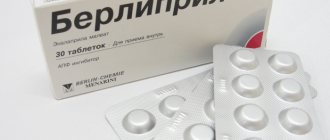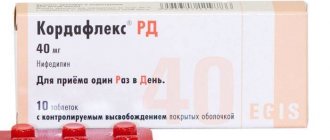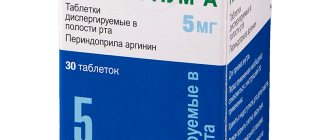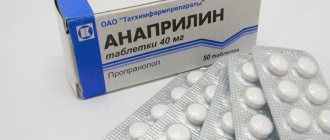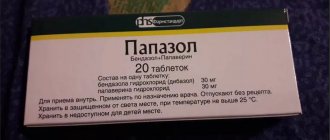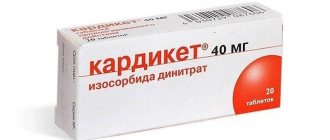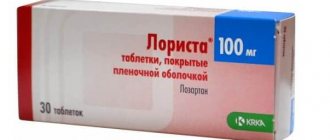Patients with hypertension are often interested in how to take Amlodipine with such a wide list of side effects.
It is used as an independent medicine. To increase the therapeutic effect, combination drugs with Amlodipine are prescribed.
You need to take the drug with extreme caution, in compliance with medical recommendations, as complications can occur.
Instructions or indications for use:
- arterial hypertension;
- stable type angina;
- vasospastic angina;
- heart failure;
- ischemic conditions;
- bronchial asthma.
Description and composition
Amlodipine is a drug from the group of dihydropyridine derivatives. Its use allows for a pronounced hypotensive effect, which occurs due to the entry of calcium ions into the cells of the myocardium and blood vessels. Taking the medicine dilates peripheral blood vessels without disturbing the heart rate.
The instructions for the drug indicate that taking the medication reduces the load on the heart, reduces the need for the myocardium to receive large amounts of oxygen, and at the same time dilates the large coronary arteries. Thanks to this therapeutic effect of the drug, it can be used not only for high blood pressure, but also for the treatment of angina pectoris. Taking pills allows you to control the attack and increase the time of physical activity.
The active component of the drug is amlodipine besylate in an amount of 5 or 10 mg, as well as auxiliary components.
Pharmacological group
Amlodipine is a vasodilator drug. The active component of the drug has the property of lowering blood pressure and providing the heart muscle and blood vessels with the necessary amount of oxygen. The main therapeutic effect of the drug consists of antianginal and hypotensive effects. Amlodipine binds to dihydropyridine receptors, dilates coronary and peripheral arteries, thereby providing the following properties:
- reduces blood pressure;
- dilates peripheral arterioles;
- reduces myocardial oxygen demand;
- eliminates spasm of the coronary arteries;
- reduces angina attacks.
After taking the drug, blood pressure decreases gradually, which does not affect the general well-being of the person. The drug has a pronounced cardioprotective, anti-atherosclerotic effect, inhibits platelet aggregation, and does not cause an increase in pulse and heart rate.
Thanks to this therapeutic effect of the drug, its use allows patients suffering from hypertension and angina to improve their quality of life, reduce the risk of complications, and normalize the functioning of the heart and blood vessels.
Amlodipine
Amlodipine can be safely used for arterial hypertension in combination with thiazide diuretics, alpha-blockers or ACE inhibitors.
In patients with stable angina, amlodipine can be combined with other antianginal agents, for example, long- or short-acting nitrates, beta-blockers.
Unlike other BMCCs, no clinically significant interaction of amlodipine was found when used together with non-steroidal anti-inflammatory drugs (NSAIDs), incl. and with indomethacin.
It is possible to enhance the antianginal and antihypertensive effect of BMCC when used together with thiazide and loop diuretics, ACE inhibitors, beta-blockers and nitrates, as well as enhance their antihypertensive effect when used together with alpha 1-blockers, antipsychotics.
Although negative inotropic effects have generally not been observed in amlodipine studies, some CBMCs may enhance the negative inotropic effects of antiarrhythmic drugs that prolong the QT interval (eg, amiodarone and quinidine).
Amlodipine can also be safely used concomitantly with antibiotics and oral hypoglycemic agents.
Single dose of 100 mg sildenafil
in patients with essential hypertension does not affect the pharmacokinetic parameters of amlodipine. With a single use with sildenafil, blood pressure control is necessary (risk of developing arterial hypotension).
Simvastatin
: Simultaneous repeated use of amlodipine at a dose of 10 mg and simvastatin at a dose of 80 mg leads to an increase in simvastatin exposure by 77%. In such cases, the dose of simvastatin should be limited to 20 mg.
Repeated use of amlodipine 10 mg and atorvastatin
at a dose of 80 mg is not accompanied by significant changes in the pharmacokinetics of atorvastatin.
Ethanol (beverages containing alcohol)
: amlodipine with single and repeated use in a dose of 10 mg does not affect the pharmacokinetics of ethanol.
Antivirals (ritonavir)
increases plasma concentrations of BMCC, including amlodipine.
Neuroleptics and isoflurane
: enhancing the antihypertensive effect of dihydropyridine derivatives.
Calcium preparations
may reduce the effect of BMCC.
When combined with BMCC and lithium preparations
(no data available for amlodipine) may increase the manifestation of neurotoxicity (nausea, vomiting, diarrhea, ataxia, tremor, tinnitus).
Studies of concomitant use of amlodipine and cyclosporine
in healthy volunteers and all groups of patients, with the exception of patients after kidney transplantation, were not carried out. Various studies of the interaction of amlodipine with cyclosporine in patients after kidney transplantation show that the use of this combination may not lead to any effect, or increase the minimum concentration of cyclosporine to varying degrees, up to 40%. These data should be taken into account and cyclosporine concentrations should be monitored in this group of patients when cyclosporine and amlodipine are co-administered.
When used concomitantly, amlodipine may increase the systemic exposure of tasonermin
in blood plasma. In such cases, regular monitoring of tasonermin in the blood and dose adjustment if necessary is necessary.
Does not affect serum digoxin
and its renal clearance.
Does not significantly affect the action of warfarin
(prothrombin time).
Cimetidine
does not affect the pharmacokinetics of amlodipine.
in vitro studies
of digoxin, phenytoin, warfarin and indomethacin
to plasma proteins Grapefruit juice
: simultaneous single administration of 240 ml of grapefruit juice and 10 mg of amlodipine orally is not accompanied by a significant change in the pharmacokinetics of amlodipine. However, it is not recommended to use grapefruit juice and amlodipine at the same time, since genetic polymorphism of the CYP3A4 isoenzyme may increase the bioavailability of amlodipine and, as a result, enhance the antihypertensive effect.
Aluminum or magnesium containing antacids:
their single dose does not have a significant effect on the pharmacokinetics of amlodipine.
CYP3A inhibitors4
: with simultaneous use of diltiazem at a dose of 180 mg and amlodipine at a dose of 5 mg in patients from 69 to 87 years of age with arterial hypertension, an increase in systemic exposure of amlodipine by 57% was observed.
Concomitant use of amlodipine and erythromycin in healthy volunteers (18 to 43 years of age) does not lead to significant changes in amlodipine exposure (increase in area under the concentration-time curve (AUC) by 22%). Although the clinical significance of these effects is unclear, they may be more pronounced in older patients.
Potent CYP3A4 inhibitors (eg, ketoconazole, itraconazole)
may lead to an increase in plasma concentrations of amlodipine to a greater extent than diltiazem. Amlodipine and inhibitors of the CYP3A4 isoenzyme should be used with caution.
Clarithromycin
: CYP3A4 isoenzyme inhibitor. Patients taking clarithromycin and amlodipine at the same time have an increased risk of low blood pressure. Patients taking this combination are advised to be under close medical supervision.
Inducers of the CYP3A isoenzyme4
: There is no data on the effect of inducers of the CYP3A4 isoenzyme on the pharmacokinetics of amlodipine. Blood pressure should be carefully monitored during concomitant use of amlodipine and inducers of the CYP3A4 isoenzyme.
Tacrolimus
: When used simultaneously with amlodipine, there is a risk of increasing the concentration of tacrolimus in the blood plasma. To avoid toxicity of tacrolimus when used concomitantly with amlodipine, the concentration of tacrolimus in the blood plasma of patients should be monitored and the dose of tacrolimus should be adjusted if necessary.
Indications for use
According to the instructions for use, Amlodipine is prescribed for patients with hypertension or angina pectoris. At what blood pressure levels you should take the drug is not easy to answer, since everything depends on the characteristics of the body. It is important to note that the drug should be taken daily, regardless of the indicators.
for adults
The main indications for taking the drug are:
- Arterial hypertension;
- Angina pectoris is stable;
- Vasospasm.
Taking the drug can be combined with other medications prescribed by the doctor depending on the pathology of the cardiovascular system.
For children
The drug is contraindicated for children, so there is no information about indications for children in the instructions.
for pregnant women and during lactation
No clinical trials have been conducted on taking the drug for pregnant and lactating mothers, so taking the medicine is prohibited.
Contraindications
Pregnancy, age under 18 years, lactation stage are the main contraindications for use.
Elderly people take Amlodipine in standard dosages; the use of this drug by elderly patients does not provoke side effects. In case of arterial hypotension and collapse, it is necessary to limit the use of the drug.
Chronic failure, individual intolerance, diabetes mellitus and renal failure, heart attack and liver dysfunction are conditions in which Amlodipine is prescribed with extreme caution.
To avoid complications, you need to limit the use of the drug when:
- low systolic pressure, when the level is below 90;
- lactose intolerance;
- the risk of allergic reactions to specific components;
- cardiovascular failure;
- pregnancy;
- young age;
- lactation.
The first month after a heart attack, the use of a hypertensive drug is contraindicated.
Applications and dosages
The dose of Amlodipine and the duration of its use are determined by the doctor individually for each patient. Basically, tablets are intended for long-term use. Admission therapy can take from several months to several years.
For adults
The tablets are intended for internal use. The initial dose of the drug for hypertension is 2.5 - 5 mg once a day. For angina pectoris, it is recommended to take ½ tablet of 5 mg per day. In more severe cases, the dose may be increased to 10 mg. The daily dose of the drug should not exceed 10 mg.
If the patient’s medical history includes pathologies of the liver or kidneys, the daily dose should not exceed 2.5 – 5 mg per day.
For children
The drug is contraindicated for children.
For pregnant women and during lactation
Amlodipine is not prescribed to pregnant and nursing mothers.
Side effects
Amlodipine is well tolerated, but in some cases, after its use, adverse reactions of the body may appear, including:
- cardiopalmus;
- dyspnea;
- dizziness;
- convulsions;
- nausea, vomiting;
- dry mouth.
If such symptoms occur, you should stop taking the drug and consult a doctor who can adjust the dose of the drug or prescribe another drug.
Which manufacturer is better?
As stated in the complete drug reference book, amlodipine is the basis of a medication that is produced in Germany and is called Norvasc.
When evaluating Amlodipine - which manufacturer is better - reviews often speak in favor of the German drug. But many patients respond positively to Amlodipine, produced in Hungary, Serbia, Belarus, India, Macedonia and the Russian Federation .
Perhaps the whole point is in the individual tolerability of this medicine or in the correct selection of the dose and adherence to the dosage regimen, but it is not easy to select from the manufacturers of Amlodipine which is better. Although you can focus on aspects that do not raise doubts - the more famous the pharmaceutical company, the higher the quality of its products, but the cost of these products can be tens of times higher.
Analogs
Analogues of Amlodipine include the following drugs:
- Norvasc is an original medicine that has confirmed its therapeutic effect in clinical trials. The drug is available in tablets that can be used for high blood pressure and angina in adult patients, including pregnant women, if the benefit to her outweighs the potential harm to the fetus.
- Amlodipine + bisoprolol is a domestic combination drug that is available in tablets. Both active components lower high blood pressure and potentiate each other’s effect. The drug is not suitable for children, pregnant women and breastfeeding women.
- Apart from amlodipine, Aprovask contains irbesartan as an active ingredient. Both substances lower high blood pressure, although they have different mechanisms of action. The medicine is produced in tablets, which are prohibited for children and patients expecting a child. Women of childbearing age should use reliable contraceptives, as the drug can cause fetal death. During therapy, the baby should be switched to artificial feeding.
- Tenochek contains amlodipine and atenolol as active ingredients. The drug has antihypertensive and antianginal effects. It is found on sale in tablets that can be used to normalize high blood pressure and angina attacks in adult patients, including pregnant women and breastfeeding women.
Analogues with fewer side effects
Is it really impossible to find an analogue of Amlodipine with fewer side effects without conducting experiments on your own health? Yes, it's not that simple. Although you can resort to a little trick and start your search with the most expensive analogues of Amlodipine, produced in Israel, Germany, Hungary, and Switzerland. Pharmacological enterprises in these countries have long established themselves as producers of high-quality products that are well tolerated by patients. As a rule, the high price of such medications is justified by the minimum side effects, so there is something to think about.
special instructions
- Before using the drug, it is important to study the instructions for use.
- You need to start taking the drug with minimal doses.
- Take the medicine only as prescribed by a doctor.
- Taking the medicine does not cause drowsiness.
- Amlodipine tablets require constant blood pressure monitoring.
- If your blood pressure does not decrease after taking the pill, you should tell your doctor.
Antihypertensive drugs, including Amlodipine, are intended for long-term use. Patients need to take the pills daily, do not miss the dose prescribed by the doctor, and in no case exceed the dose of the medicine.
While taking Amlodipine tablets, it is important to adhere to a diet, reduce the intake of salt, spicy and fried foods.
How long can you take Amlodipine without interruption?
Patients are wondering whether it is worth taking Amlodipine without interruption. The list of side effects that occur from uncontrolled and continuous use of the drug is very wide.
To avoid harm to the body, do not exceed the dosage of the medicine. It is prohibited to start a new therapeutic course without a break.
The dosage, duration of the course and break during treatment with Amlodipine should be determined by the attending physician. Unauthorized increase in dosage and uncontrolled use can provoke the development of side effects.
